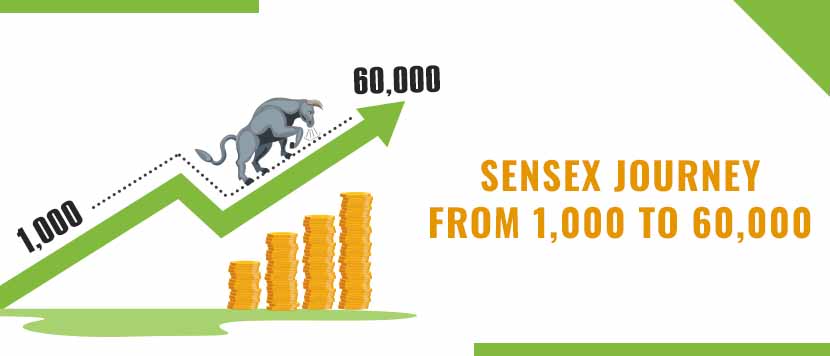Journey of Sensex from 1,000 to 60,000 in 31 Years

Last Updated: 9th December 2022 - 10:28 am
The Sensex, which began its journey at 100 in 1979 has traversed all the way to 60,000 in 2021. That is a 600-bagger over 42 years, but we come back to that later. The first time the Sensex touched the 1,000 levels was in July 1990. From that point, the Sensex has been a 60-bagger over the last 31 years almost coinciding from the point Dr. Manmohan Singh opened up the Indian economy.
However, the journey is a lot more interesting. The first 10-bagger move from 100 in 1979 to 1,000 in 1990 happened over 11 years. That is annual CAGR yield of 23.3% and still remains one of the best rallies on the Sensex. The next 10-bagger happened after nearly 16 years as the Sensex scaled 10,000 in February 2006. That is an annualized yield of 15.5% over 16 years.
The move from 10,000 to 20,000 on the Sensex happened in exactly 21 months in Oct-07. However, the journey to 30,000 took 7 years due to the global financial crisis. The next move to 40,000 took a little over 4 years up to May 2019 and only happened in the aftermath of the NDA being voted back to power for a second time.
The move from 40,000 to 50,000 took 17 months, but this is despite the fact that the Sensex had corrected nearly 35% to around the 25,700 levels in March 2020 on COVID-19 fears. The final move from 50,000 to 60,000 happened in just 8 months as the Sensex scaled from 50,000 in Jan-21 and 60,000 in Sep-21. This journey would have been much shorter but for the COVID 2.0 intervention.
How did Sensex perform over last 31 years in terms of CAGR returns?
If you had invested in the Sensex in July 1990, your money would have multiplied 60-fold in 31 years implying CAGR returns of 14.12%. However, had you held on to the Sensex for the full 42 years since 1979, your CAGR returns would have been 16.46% over 42 years, excluding dividends. The Sensex journey is the story of Indian equity as an irresistible asset class.
- Flat ₹20 Brokerage
- Next-gen Trading
- Advance Charting
- Actionable Ideas
Trending on 5paisa
Indian Stock Market Related Articles
Disclaimer: Investment in securities market are subject to market risks, read all the related documents carefully before investing. For detailed disclaimer please Click here.
 5paisa Research Team
5paisa Research Team
 Sachin Gupta
Sachin Gupta




